Opencart Helpdesk module provides support to their customers. It is a software suite that enables customer support to receive, process, and respond to service requests. Help desk builds on the definition to serve their customers by creating a powerful ticket-management platform that allows you to centralize all tickets with ticket status, priority, types, and many more. We can easily increase productivity by automating our ticket management via SLA, Events & Triggers, Ticket Rules, etc. The help desk enables the support via web and email.
The OpenCart helpdesk module is the best helpdesk module for the Opencart store owners and admins. With the help of this module, customers can generate tickets for the store and the store owner/admin can easily manage those tickets this module.
Note – You can also build your custom help desk system using UVdesk.
UVdesk: Cloud-based helpdesk system
Webkul is proud to announce our cloud-based helpdesk system “UVdesk“. UVdesk is super handy to use with tons of features like ticket generation via email, knowledge-base, online form builder, automatic actions or workflow, reports, customizations, and much more.
Features for Opencart Helpdesk
- Working with All the Templates ( Including Responsive Themes) and source code is Open so can be easily customize.
- Allow admin to create ticket status, ticket priority, ticket types, and ticket custom field.
- Allow to Merge tickets.
- Email tickets fetch support.
- It allows split thread as a new ticket.
- It allows the admin to create customers.
- The admin creates an organization and manages tickets based on the Organization level.
- Admin can create multiple Agents and agent levels.
- The Admin can create unlimited agent groups and create roles.
- Ticket Lock feature support.
- Admin can define business hours and holidays based on SLAs.
- Event Triggers support found.
- Allow admin to prepare responses with action.
- Allow admin to create a support center category.
- Admin can create Service level agreements (SLA).
- Complete Agents management system.
- Custom fields support tickets.
- Complete and flexible ACL system.
Installation for Opencart Helpdesk Extension
Installation of the Opencart Helpdesk module is very simple. In the zip file, you will find some files which need to upload to the root directory of your open cart website.

After that, uploading the file you need to go to the Extensions -> Modification then clicks on the refresh button.

Now, after that in the Admin panel go to System -> Users -> Usergroup and edit ‘Administrator’ and select all for both Access and Modify Permission then save it.
Configuration
After that, under extension>module install the Helpdesk module this way-
Admin can edit Helpdesk configuration setting by clicking option and below page will be open.
- Admin can set Helpdesk’s status enable/disable.
- Admin can set date format i.e Y-M-D or D-M-Y as per the PHP so that the helpdesk will show dates in this format.

- ACTIVITY LIMIT DASHBOARD– Admin can limit the number of activities to be shown in the dashboard. A number of activities will refer to the activities agents perform or Admin on the tickets like- status change, priority change, etc.
- GENERATE ACTIVITY– Admin can select the option for the activity will generate.
- SELECT ACTIVITY PRIORITY– Admin can set priority for the activity.

- SHOW HEADER– The helpdesk header will be shown on set pages.
- INFORMATION LIMIT– Enter numbers of information(s) that will display on the support center page with categories.
- CATEGORY INFORMATION ORDER– Information will be shown by “old to new” or “new to old”

Under Ticket
Therefore, the first admin needs to add the ticket status. The ticket status can be added under “Helpdesk > Tickets Management > Status”. 
After that, here the admin enters the details as required.

Name – Enter the name of the status as per the requirement.
Description – Enter the description of the status.
Status – status whether “Enable” or “Disable”.
TICKET STATUS
- Ticket open– Set status when a ticket is open.
- Ticket new– Set status when a ticket is new.
- Ticket pending– Set status when a ticket is pending.
- Ticket solved– Set status when a ticket is solved.
- Ticket closed– Set status when a ticket is closed.
- Ticket spam– Set status when a ticket is a spam.

DEFAULT
Whereas, the admin can set default values for those tickets which are not complete.
- First is default status– Show set default status when the status is not defined.
- The second is default ticket type– Show the set default ticket when the type is not select.
- The third is the default group– Set the default group when the group is not selected.
- Forth is default priority– Show set default priority when priority is not defined.
ADMIN TICKET VIEW
- Ticket thread limit– Admin can set ticket thread limit. e.g-1,2,3. So that customers can see only that number of tickets and if they want to see all the tickets they can expand it.
- Draft saving time– Admin can set draft saving time. So that whenever any agent or admin will be typing a message it will automatically save after that specific interval of time.
- Lock view time– Admin can manage the lock view time.
- Lock expire time– Admin can manage lock expiration time.
- Note for action– Admin can set the note for action. If the admin sets YES then the admin can add a note to the ticket based on any condition or events&triggers, If NO then a note will not be shown.
TICKET GENERATE / VIEW SETTING for Opencart Helpdesk
-
-
- Requirements of login for tickets– Admin can set login requirements for the ticket (yes/no). If the admin set login requires YES then customers have to log in by their accounts and then can generate tickets. If NO then any customer can generate a ticket without logging in to the helpdesk.
- Ticket fields– All selected fields will display to customers at the time of ticket generation.
- No. of files– Admin will allow limit number of files to be upload. This feature can give a facility to those admins who have a shortage of disc space.
- The file size– Admin can limit the file size that can upload by the customers.
- Requirements of file extensions– Admin can allow all or with a limit of file extensions for customers.
- Requirements of ticket fields– Validation will work for only a specific selection of fields at the time of ticket generation.
- Allow editor– Admin can set allow editor to- YES/NO. If the admin sets YES then the customer can use the editor or if the admin sets no then customers can’t use the editor.
-
Customers can delete tickets
- Customer can delete ticket thread– Admin can allow or restrict the customer to delete the ticket thread.
- Can update status– Admin can allow or restrict the customer to update status.
- Can add cc– Admin can allow or restrict the customer to add cc.
Opencart Helpdesk – Admin Management
After the installation and configuration help desk will be displayed under the admin panel.
Under Helpdesk, there are various menus we will explain them one by one.
In the Helpdesk dashboard, the admin can view the Ticket status and Recent activity.
Under the dashboard, the admin can see the ticket status and recent activities.
TICKET STATUS: Here admin can see the different statuses of various tickets like- Pending, New, Open, Closed, Resolved, and Spam. By clicking on any status admin can see all the tickets under that status.
RECENT ACTIVITY: This section shows a list of all the recent ticket activities which have been performed.
Ticket Management
After the dashboard, there is a ticket management option.
1. Ticket:– Under ticket management, there are various options for the admin to view and manage the ticket, status, type, priority, and customs fields of the ticket.
In this menu, the admin can see various tickets and their priority, status, assigns to an agent, and type. Admin can search any ticket using filters available in the ticket menu.
Admin can search the ticket by using various filters like- Ticket i.d, Requester, Agent, Group, status, type, priority, tags, ticket source, and creation date.

-
- Assign agent: Admin can select any ticket and can assign agent directly
- Assign group: Admin can select various tickets and can assign the group to them.
- Status: Admin can select various tickets and can change their status.
- Bulk action: Admin can also choose the bulk action to update various ticket features in a single platform.
- Merge: Admin can easily merge 2 or more ticket just admin have to select the primary ticket and then have to click on save than those tickets will show into the primary ticket.
Edit Ticket
In this admin can reply ticket or can assign it to a particular agent and group, so that the ticket will be resolved and closed as soon as possible.
- Reply: Admin can reply to tickets from this screen.
- Add cc/bcc: Admin can add cc bcc for the reply if enabled from the backend option.
- Forward: There is a feature that Admin can forward the ticket, by clicking on the forward button the ticket content will appear in the reply text field.
- Ticket note: This ticket note can be added by one who will be working on the ticket. Admin/Agent can add notes for future references.
- Ticket tags: This ticket tag can be added by the one who is working on the ticket. Tags help the Agent/Admin to search the tickets in the future using filters.
- Lock view: This feature indicates one or more agent is viewing that particular ticket. If only one agent is viewing or doing some work in that ticket then the marker will be blue and if more than 1 agent is viewing that particular ticket then the marker will turn red and show a pop-up with the name of the agent working on it that particular ticket.
- Add a note: Admin can add internal notes to the ticket which will be visible to the agents only.
- Mark spam: Admin/agent can mark the ticket as spam by clicking the mark spam button.
- Delete: Admin/Agent can delete tickets by clicking on the delete button.
- Previous/Next button: Here Admin/Agent can easily go to the previous or next ticket by clicking on those buttons.
Response
- In this agent will choose a response from the list of responses that have made earlier for the ticket, response will include various actions like-Group update, Priority update, reply added, etc so that it will be easy for the agents to add a response to a ticket.
2. Status: In this menu, the admin can manage the ticket’s status, the admin can create, delete, or enable/disable the status. And the admin can update/edit the existing tickets. admin can search tickets by using various filters like- Date-updated, Status, and Name.
Add Status: In this admin can add status, the admin has to set NAME and DESCRIPTION of the status furthermore, the admin has to enable or disable it from the radio button.
3. Priority: In this menu, the admin can manage the priority status list. Admin can create new priority status, and the admin can also delete, enable/disable, or can edit the existing priority status.
Add priority: In this admin have to set the name and description of the Priority, after that admin has to enable or disable the priority from a radio button provided under and save it.
4. Types: In this menu, the admin can manage types of tickets. Here admin can add a new type of ticket and the admin can also delete, edit, and enable/disable the existing types of ticket.
Add type: In this admin have to set the name and description of the type, after that admin has to enable or disable the type from a radio button provided under and save it.
5. Ticket’s custom fields:
In this menu, the admin can add new custom fields to get additional data & information about the ticket from the buyers. So admin can add any number of custom fields and the admin can also edit the existing custom fields.
Add ticket custom field: In this admin have to fill in the information like name location to make a custom option.
Therefore, the admin has to set the field dependency on any ticket type then the custom field will be displayed to that ticket type only. If the Admin wants to show it to every ticket then just has to leave it blank.
For example: If there is a custom field named Order i.d so order id will be needed in some specific ticket type like- support ticket so we will set field dependency to that ticket type only then it will only show to support tickets. If there is another ticket that is for pre-sale then the custom field- order i.d will not be displayed.
Admin will select a group to show this custom option to that customer group
After that, the admin will configure the custom field like enable/disable and sort the order of the custom field.
Customer Management
After that, the customer management dropdown occurs under this there are two options-
Customers: In this Admin can add customers and can delete or edit the existing customers. Admin can also find the customers by using the filter.
Why make customers?
By making customers it will merge the data of the store’s customers with the same customer of helpdesk and by merging the data synchronization will be easy.
Add customer: In this admin creates a customer by filling in all the information about the customer like Name, Email, OC customer, and Organisation and add it.
Organizations: In this Admin can add organizations and can delete or edit the existing organizations. Admin can also find the organizations by using the filter.
Why make Organisation?
By making an organization the admin/agent can add various customers in an organization so that handling the customers of the same organization will be easy.
Add Organisation: In this, the Admin creates an Organization and fills its details in the form, and saves it.
Admin have to fill the organization’s name and description at first then-
Domain: Admin has to fill in the domain details of the organization.
Notes: Admin can add notes for this specific organization for future references.
Customers: Admin can easily add customers for this particular group.
Customer role: In this, the admin can enable or disable the customer role. Customer role gives the option to the customer to edit the tickets of the particular Organisation.
Groups: Admin can add groups to this organization to define a way for this organization, ticket assign process.
Agent Management
Agents: In this Admin can add Agents and can delete or edit the existing Agents. Admin can also find the Agents by using the filter.
The agent can reply to tickets assigned by the admin.
After defining the roles of the agent. They can do various tasks defined to them like- Can edit tickets, Updating the status, setting priority, etc.
Add Agent: In this, the admin creates a new agent and fills in all the details about the agent like who will be the agent(the only user of that OpenCart can be an agent).
Now, the admin can set the agent alias name.
The admin can define a group to the agent and save it.
Additionally, the admin/Agent can set their signature so that they can add it in the reply.
Role: The roles which have been created by the admin will be displayed and the admin has to select from that role for the agent.
Ticket access level: Admin will select the Ticket access level like- Own ticket access, Group access, and global access.
Own ticket access: In this admin can restrict the agent to reply and edit his own tickets only which have been assigned by the admin.
Group access: In this agent have the access to the tickets of every agent in a particular group. An agent can reply and edit any ticket of that particular group.
Global access: In this, the agent will be able to access all the tickets of the helpdesk and can reply or edit any ticket.
Agent level
Admin can even divide the agents up to a few levels like Expert, High, Low. In this Admin can add Agent level and can delete or edit the existing Agent level. Admin can also find the Agent level by using the filter.
Add Agent level: In this admin creates a new agent level by filling in all the information about the agent level like Name and Description then has to select from Enable/Disable and save it.
Groups: Admin can organize the agents into different groups so they could focus on one kind of problem, and get to know the solutions and customers better. In this Admin can add Groups and can delete or edit the existing Groups. Admin can also find the Groups by using the filter.
Add Groups: Here admin will create a new group by entering information i.e Name & description and then select enable or disable and then save it. While adding the group Admin can choose agents for that particular group.
Admin will also select the business hour for the group.
Roles
Agent’s roles will specify what an agent can see and do within the helpdesk system. Admin can use a filter to search a role and can add or delete various roles. By creating a new role with various tasks and responsibilities the admin can change the roles of any agents.
Add role: In this admin will add a new role by filling in all the information about the role and selecting various work from the menu. In this, after adding various tasks and responsibilities in it admin can assign that role to any agent.
At first, Admin has to set the name and description of the role.
Default roles: After adding the role’s name & description there will be default roles i.ethose roles that are defined for everyone and can’t be changed. (Dashboard, notes)
Ticket: Using these roles admin can give permission to the agents to access tickets so that they can manage tickets.
Agents Using these roles admin can give permission to agents to manage other agents i.e add new agents, edit agents, and delete agents.
Admin roles: These are admin roles, by giving these roles admin is giving permission to an agent like the admin has in the helpdesk.

Business Hours
Admin can add business hours. Using business hours you can customize the work timings based on when you are actually working. Admin can also set up holidays as exceptions to the business hours set in their schedule.
In this admin can see the list of business hours and can also search with the help of the filter. Admin can also add a new business hour or can delete the existing one. Admin can add a Holiday list.
Add business hour: In this admin can add new business hours by filling all the information and details to it and then save them.
At first, the admin has to fill in the name & description of the business hour.
After filling, the above Admin has to set the time zone in which they are working.
Then the admin has to set the times of the weekdays. Like- we have mentioned 9 am to 6 pm timing which is the standard working time in India
Holiday: Admin can add a holiday list by adding various holidays.
Responses
In this admin can see all the responses and can edit those responses. admin can also add new and delete the existing responses.
Add response: In this admin will add new responses by filling in all the information about the responses
At first, the admin has to define the name and description of the response.
Action: Admin then will set the action i.e by using this response what action will be performed to the ticket.
For example: If admin/agent will define the action of a response to set priority, set status, set type. Then by choosing that response on the EDIT TICKET page it will work the same as defined.
Can use: In this option, the admin can select that who can use the response i.e Only me, all agents or groups. If the admin selects groups then the admin has to select the various groups which can use priority from a dropdown menu.
Support Center – Opencart Helpdesk
In this, the admin can see all the support centers and can edit the existing support centers. Admin can also add new or delete the existing support centers.
In the support center, the admin will create some predefined questions and their replies so that whenever a customer has a query or needs support in some common issue they can easily read the solutions from those support center templates.
Add support center: In this admin will add new support centers by filling in all the information about them and saving them.
At first, the admin has to set the name and description of the support center template
After that Admin has to select for which category this support center will be displayed.
After that, admin will set it to enable or disable.
Setting – Opencart Helpdesk
Admin can configure settings as per the need of the helpdesk. so that it can perform all the tasks perfectly. Under settings, there are various sections like connecting email(s), activity, SLA, event triggers, ticket rules, and email templates.
Email is a medium for customers to submit tickets to the Helpdesk and have conversations with agents to resolve their issues. When a customer sends an email to the email address, the email creates a ticket in the Helpdesk. If an agent updates the ticket in the Helpdesk, a notification email is sent to the person who sent the original email.
Webkul helpdesk system is the one and only helpdesk system in the world that provides an email piping feature that means your customer can reply directly from their email and they don’t need to login to the ticket system.
Add email
In this, the admin can add email by filling up all the required areas and then can save it.
At first, the admin has to set the Name and Description then the admin has to write the email i.d so that it can be configured further for Email piping.
After that, the above details admin has to fill in Username, Password, Hostname, Port, and Protocol to configure the Email piping.
Then admin has to set the Email fetching time so that after that intervals the emails will be fetched.
After that, setting the time to fetch, Admin has to set no. of emails to be fetched.
HELPDESK Action: In this admin will set the action to be taken for the fetched emails.
After that, the admin has to set default values for the Emails/tickets i.e Default Group, Default type, Default Priority.
Basic information of the email
Firstly, you have to fill in the basic information of the email.
Name: In this, you have to write the name of the email to which you want to connect.
Description: In this, you have to write the description of the email or you can write anything about that mail.
Email: Here you have to enter the full email address to which you want to connect. For example the complete email address([email protected])
Next, you have to configure the email piping (IMAP/POP)
Username: In this, you have to enter the username of the email. For example- Your full Gmail address ([email protected]).
Password: In this, you have to enter the password of the above account.
Hostname: After entering the basic information you have to enter the Host name of your mail provider. You can see various details for the configuration of different email providers.
Port: In this, you have to fill in the port number of the email. Please refer the below screenshots.
Mailbox: In this, you have to write the name of the mailbox.
Protocol: In this, you have to select the protocol which you want to select.(IMAP/POP)
POP and IMAP are protocols that allow you to download messages from (Gmail, Yahoo, and Hotmail) servers onto your computer so you can access your mail with a program like Microsoft Outlook or Thunderbird, even when you aren’t connected to the Internet.
Email services setting for Gmail
if you are using Gmail then you have to enter imap.gmail.com as hostname, and 993 as a port. For more details visit https://support.google.com/mail/troubleshooter/1668960?hl=en
For configuring IMAP
For configuring the POP
Here’s how to enable POP in Gmail:
Sign in to Gmail.
Click the gear in the top right .
Select Settings.
Click Forwarding and POP/IMAP.
Select Enable POP for all mail or Enable POP for mail that arrives from now on.
Choose what to do with your messages after your POP client or device receives them.
Click Save Changes.
Email settings for Yahoo
For configuring the IMAP
For configuring the POP
Email settings for Hotmail
Fetch time: In this, you have to set a time for fetching the emails from the mailbox to the helpdesk.
Fetch Emails (No.): Here you have to set the number of emails to fetch a single time in the helpdesk.
Helpdesk action: Here you have to select the action of the helpdesk for the emails to be fetched.
After configuration, you have to set the default values for the mail for this particular mailbox.
Default Group: Here you have to choose the default group in which these emails are to be assigned.
Default Type: Here you have to select a type as default for the email of this mailbox.
Default Priority: Here you have to select the default priority that assigns to the mails of this group.
Status: You have to set the status as enable or disable of this mailbox.
Activity
Admin can see the activities in this section. Admin can also delete the Activities.
SLA
Admin can create SLA Policies from here. With the help of these SLA policies, Customers want to know when they can expect a response and resolution from you when they submit a support request. A service level agreement (SLA) policy lets you set standards of performance for your support team. You can set SLA policies for the time within which agents should respond, resolve tickets based on ticket priorities, and set up automatic escalation rules to notify specific agents about SLA violations.
Add SLA: At first, Admin have to set the name and description of SLA
SLA Ticket priority: In this admin have to set Ticket Respond Time, Ticket resolve time, Working hours, and status with respect to ticket’s priority.
At least one condition for SLA to apply: In this admin have to select various conditions, so that if any one of those conditions will apply then the SLA will work.
All conditions for SLA: In this admin will select various conditions and if all the conditions will apply to a single ticket then this SLA will work.
Sort Order: In this admin have to select the sort order because the SLA policy will work according to the sort order. If one will match the condition then that policy will work not the next one.
SLA policies have a set structure. Each SLA policy has:
-A set of conditions that a ticket must satisfy in order for the SLA policy to be applied.
-The target time for each desired condition and a priority value.
-One or more conditions that you choose to measure.
-Whether targets will be measured in business or calendar hours.
Event triggers
Triggers contain conditions and actions. You can use it to modify the status, change priorities and even send out notification alerts as soon as certain conditions are met. For example, a trigger can be used to notify the customer when a ticket has been opened.
Add event & trigger: In this admin add a new event and trigger from here. There are two types of conditions – all conditions and any conditions. In all conditions, Events & triggers will work only if all conditions are true. If any of the condition statements fail (are not true), the trigger will not act on the ticket. Whereas in the conditions, Events & triggers will work if at least one condition is true.
At first, the admin has to set the name and description of the event&triggers.
Events: Admin has to select an event or various events for the Events&Triggers.
Select event(s) Performer: In this, the admin has to select the performers for the event and who will perform for the event.
At least one condition for events&trigger to apply: Admin has to select various conditions. If at least a single condition matches with any ticket then this Event&Trigger will work.
All condition for events&triggers: Admin will select various conditions from the list and if all the condition matches then this Event&trigger will work.
Action: Admin can add various actions which will happen to the ticket.
In the end, the admin can set it to enable or disable.
Ticket rules
The ticket rules apply to every new ticket coming in and perform actions based on specific conditions. You can use the ticket rules to
- Assign the ticket to the right agent.
- Set status, priority, and type.
- Send email notifications to agents and groups.
- Delete tickets or mark them as spam.
These actions will execute on a ticket if it matches certain conditions. Admin can see the list of ticket rules from this menu. And the admin can also edit the existing ticket rule. Admin can also add a new ticket rule or can Delete the existing one.
Add ticket rule: In this admin can add ticket rules from here.
Email templates
Admin can see the various templates and can edit the existing template. Admin can make new templates or can delete the existing template
Add email template: In this admin can add a new template for email by adding various information about the new template.
Opencart Helpdesk – Front end
Customers can generate a ticket from this page here. They need to fill all the requirements to generate a new ticket. Customers can see their existing tickets from ticket status. At the customer end, the help desk screen will display
After that, generating the ticket customers can see their all tickets from the Ticket status option.
Customers can easily add replies to the tickets and also can add attachments if the admin will enable it from the back-end.
Therefore, customers can go to the previous or go to the next ticket by clicking on the arrow buttons.
Customers can expand the ticket threads with one click only.
Support Center
In this fields, the customer can see the Support Center Category that the admin can add.
If you still have any issues feel free to add a ticket and let us know your views to make the module better https://webkul.uvdesk.com/.
Current Product Version - 3.1.1.7
Supported Framework Version - 2.x.x.x, 3.x.x.x
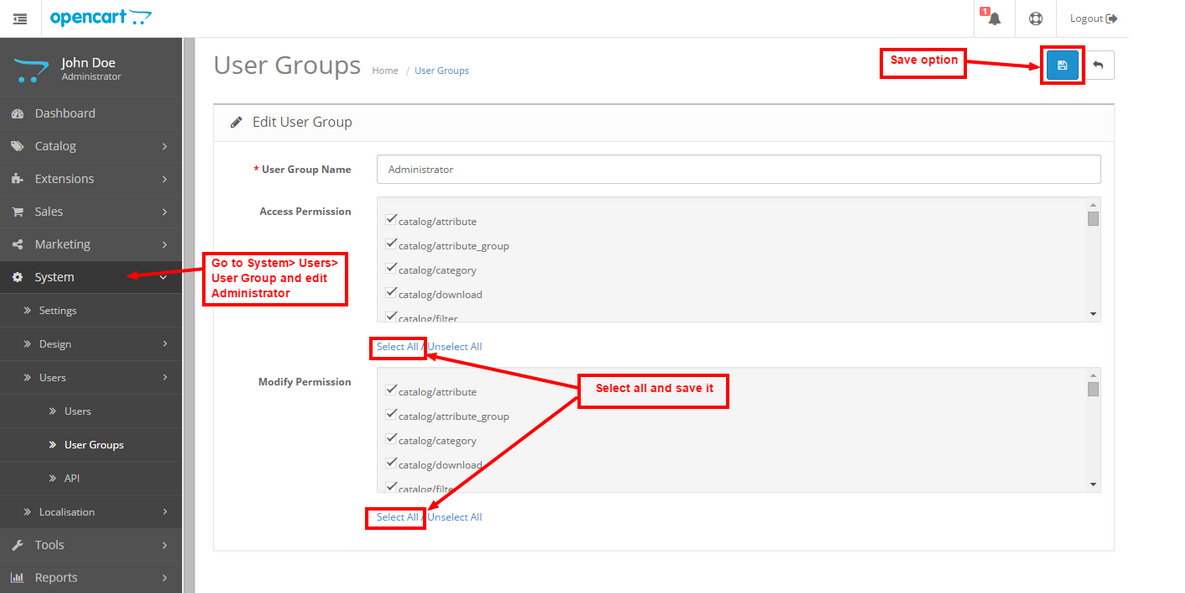
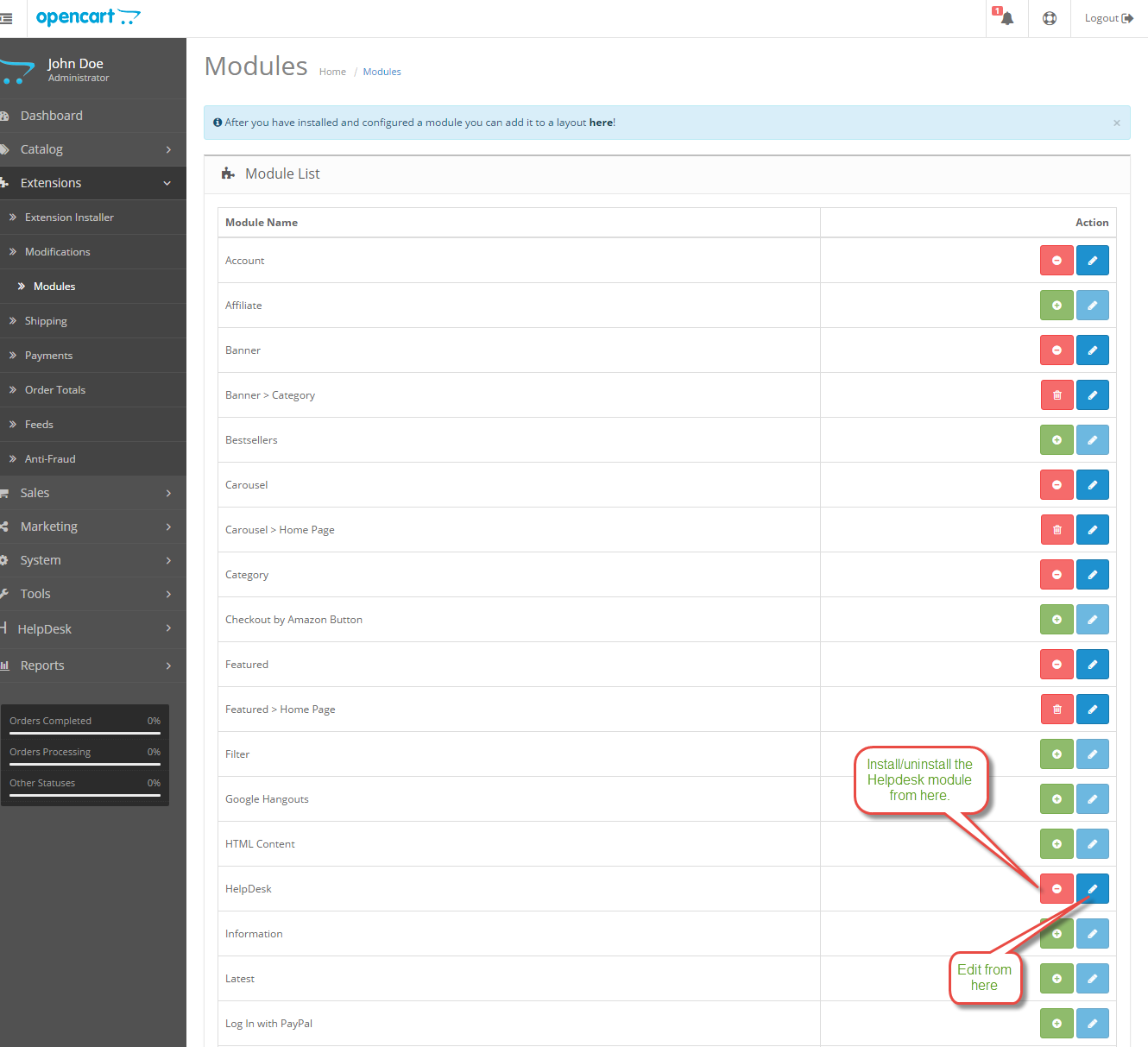













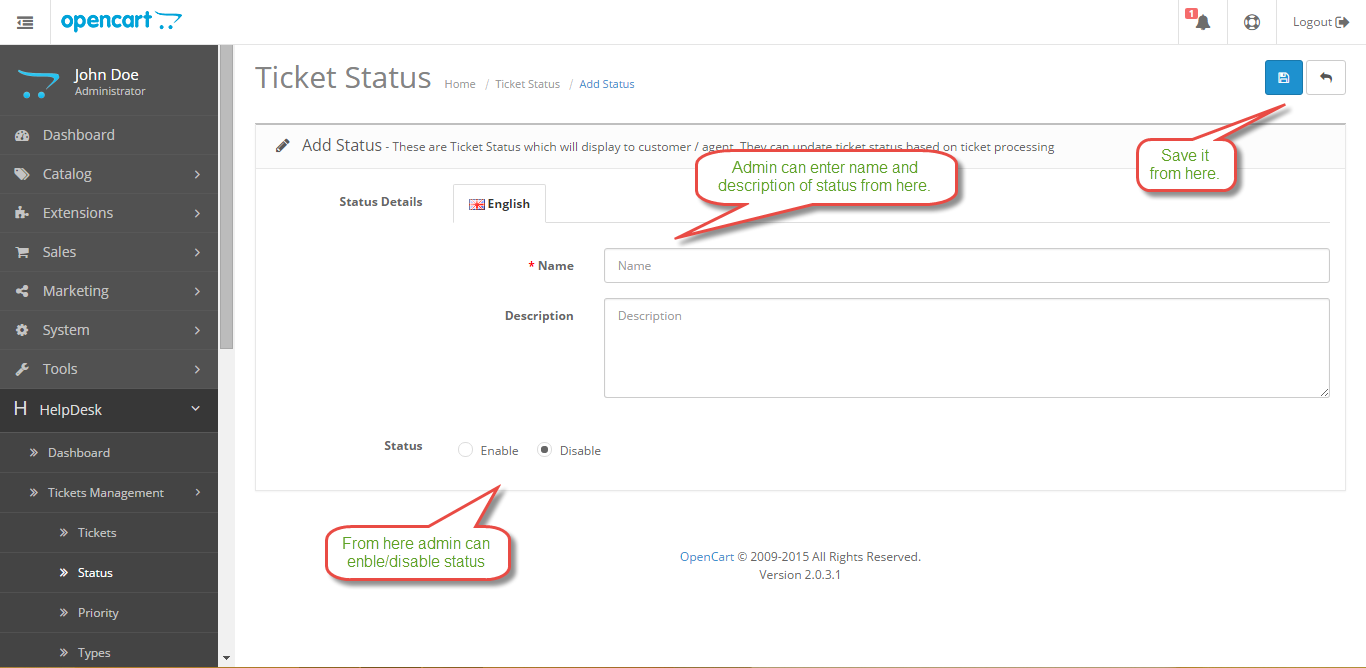




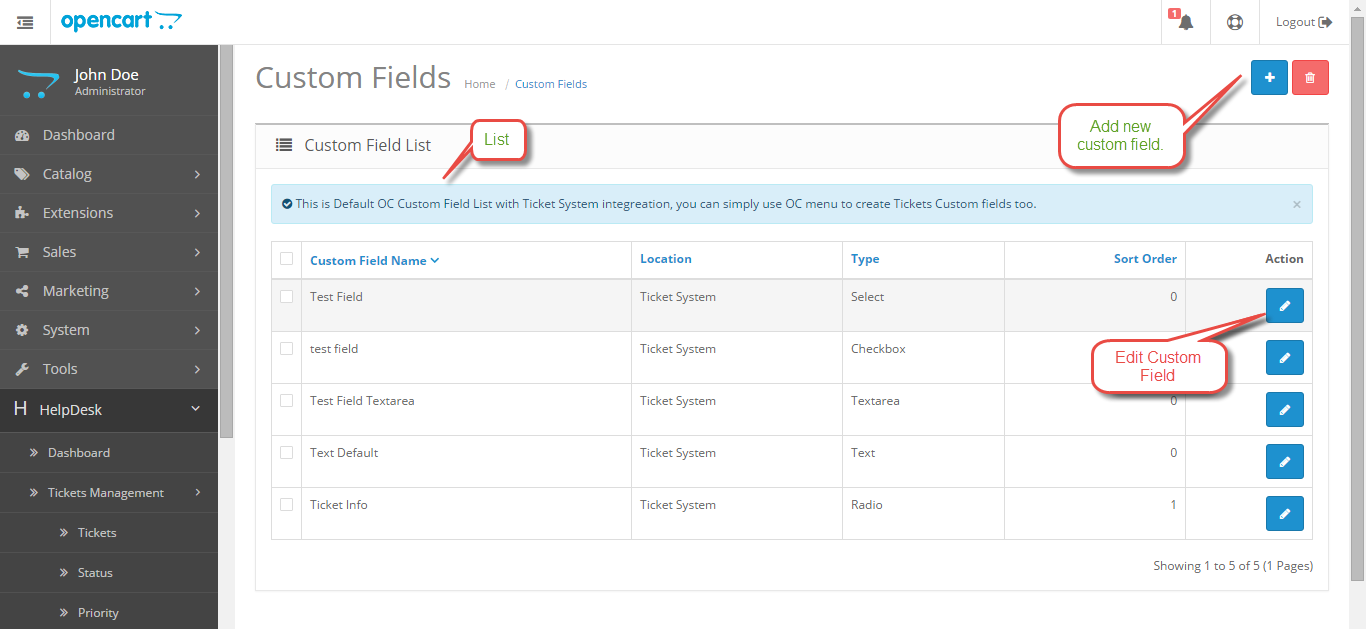



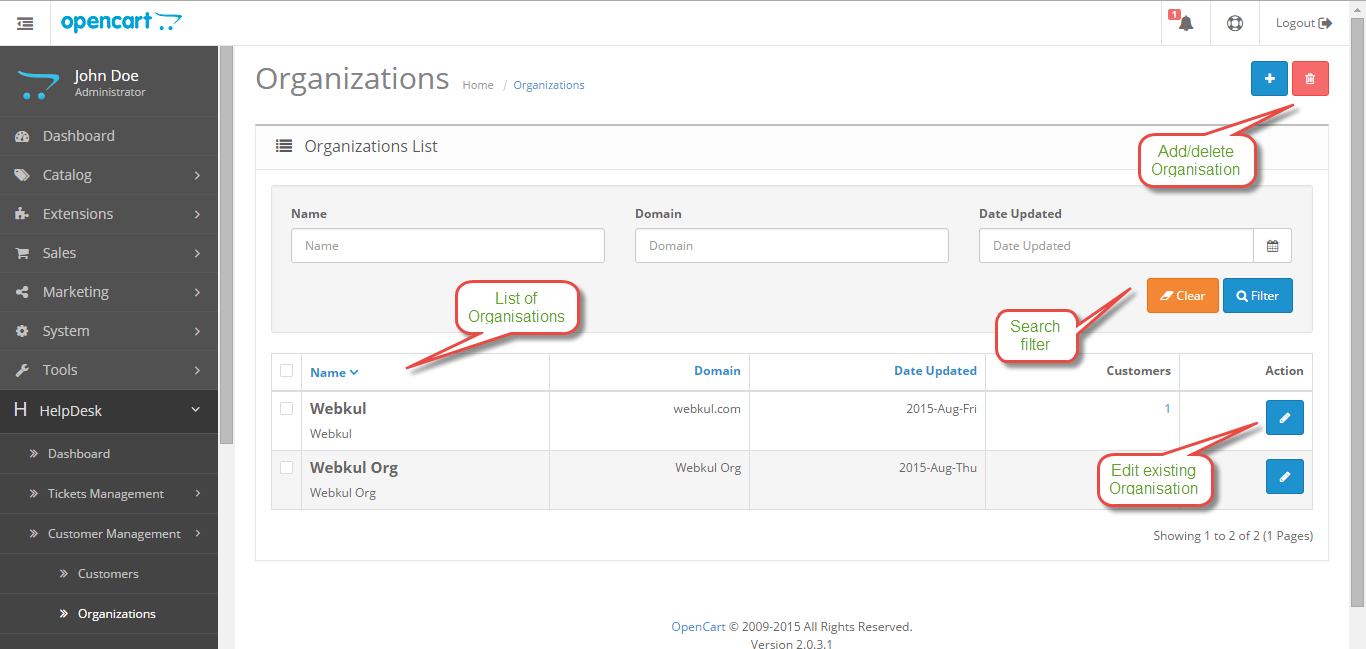


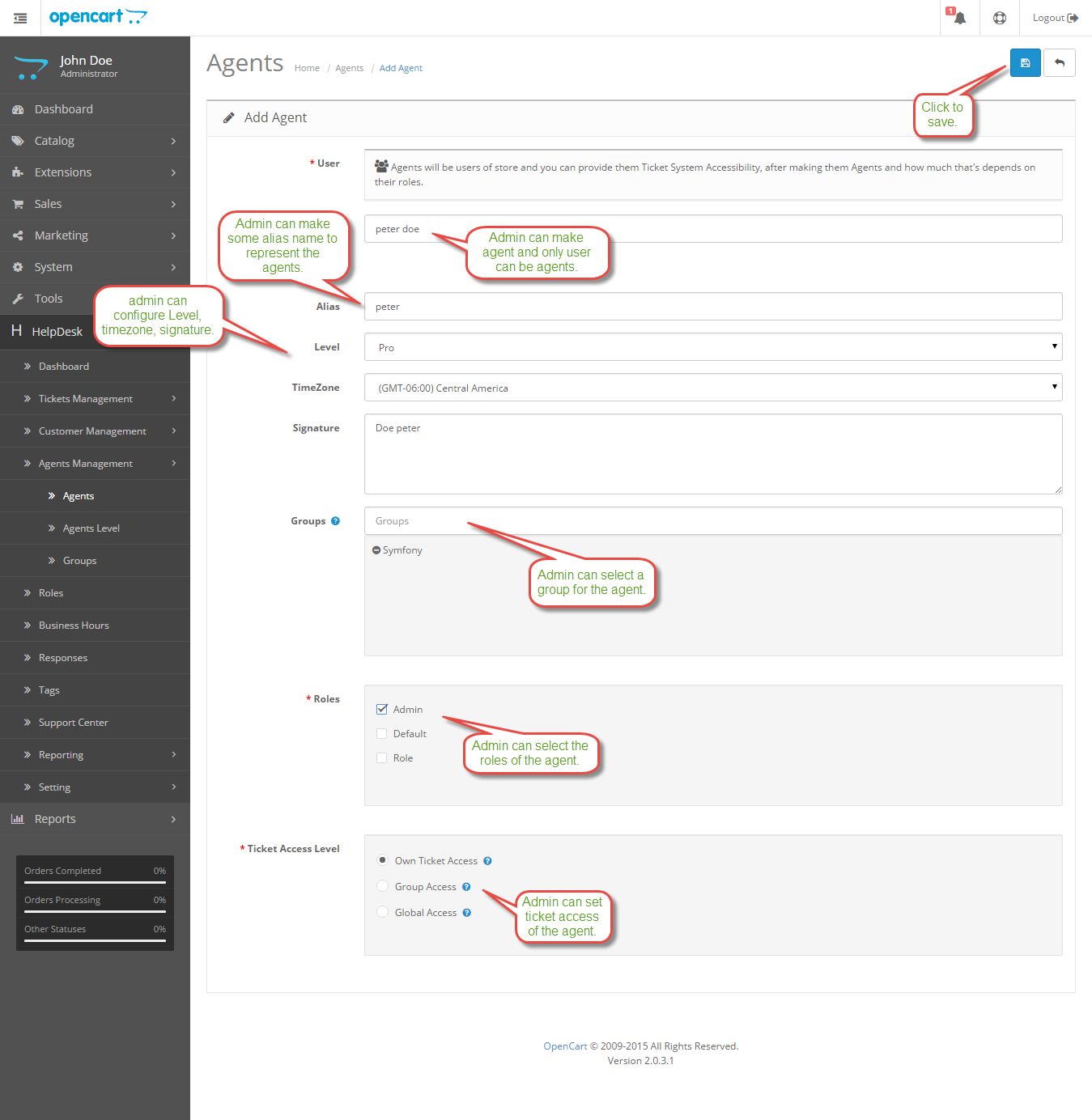
























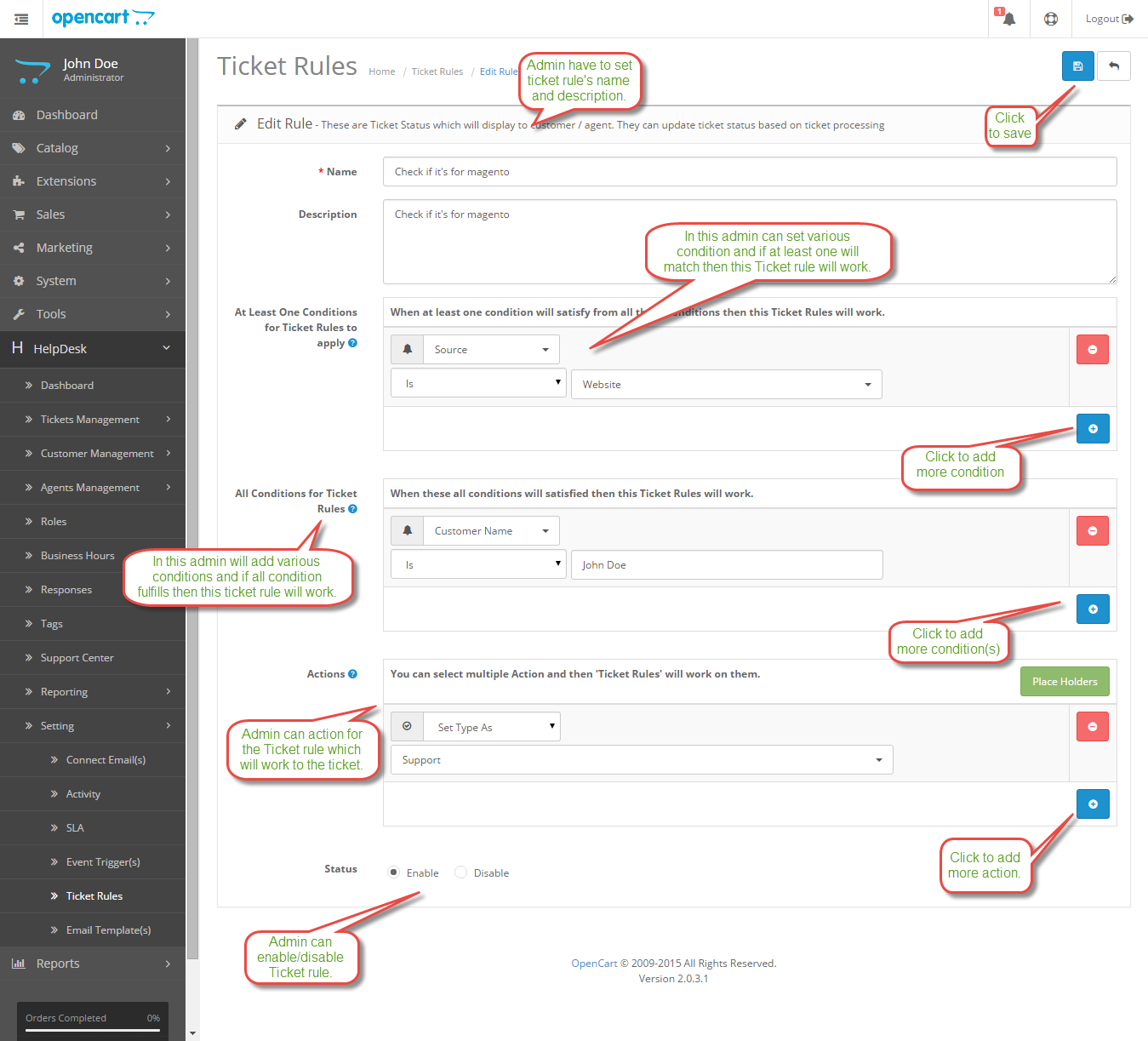




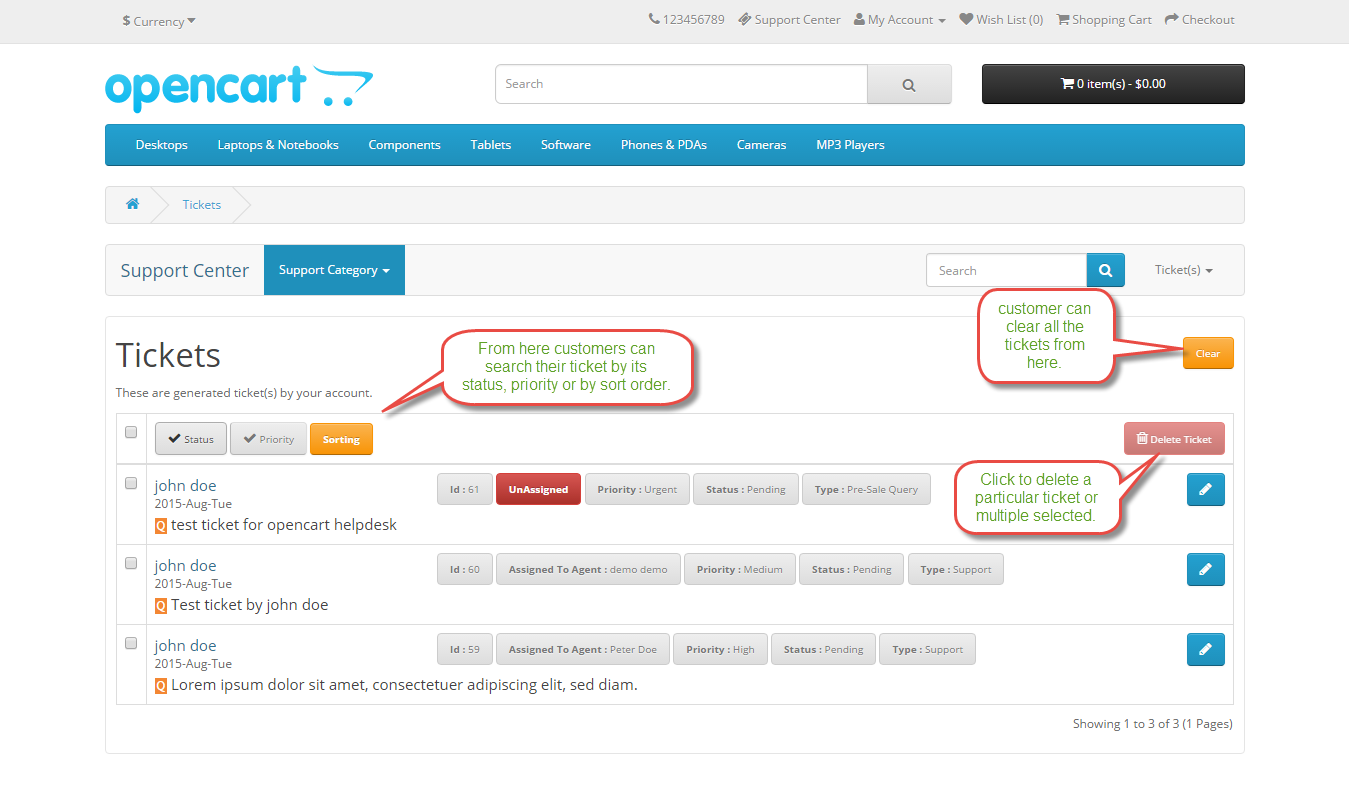
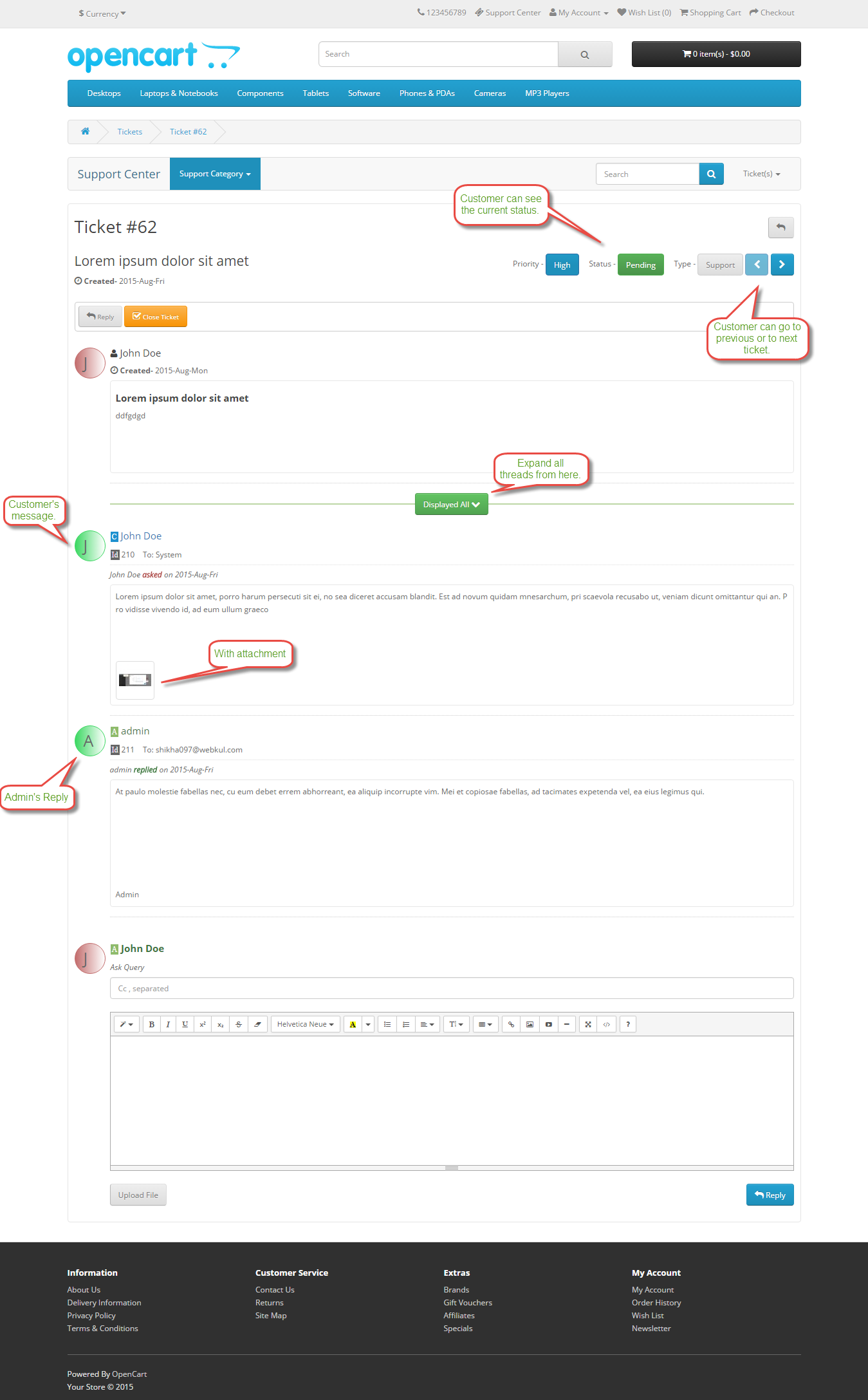

Be the first to comment.